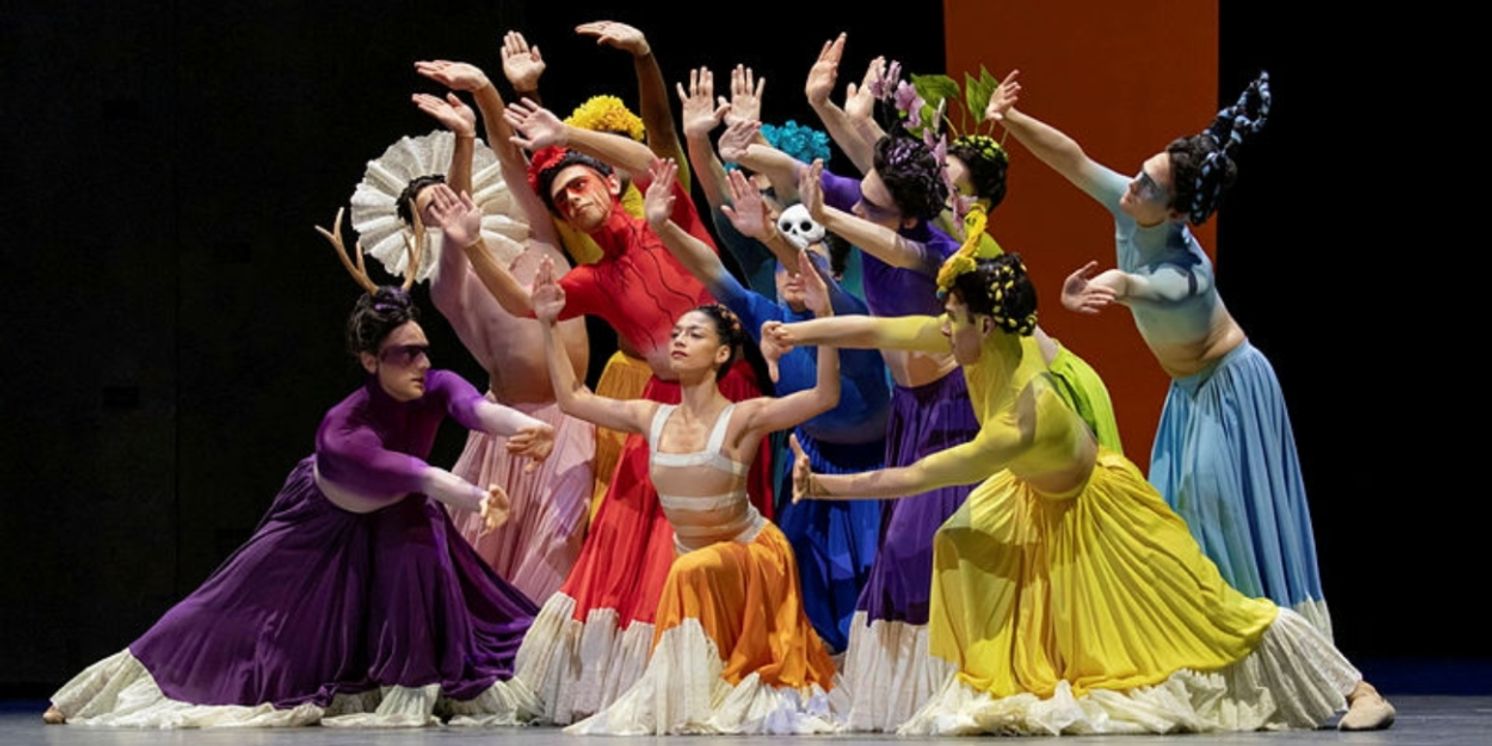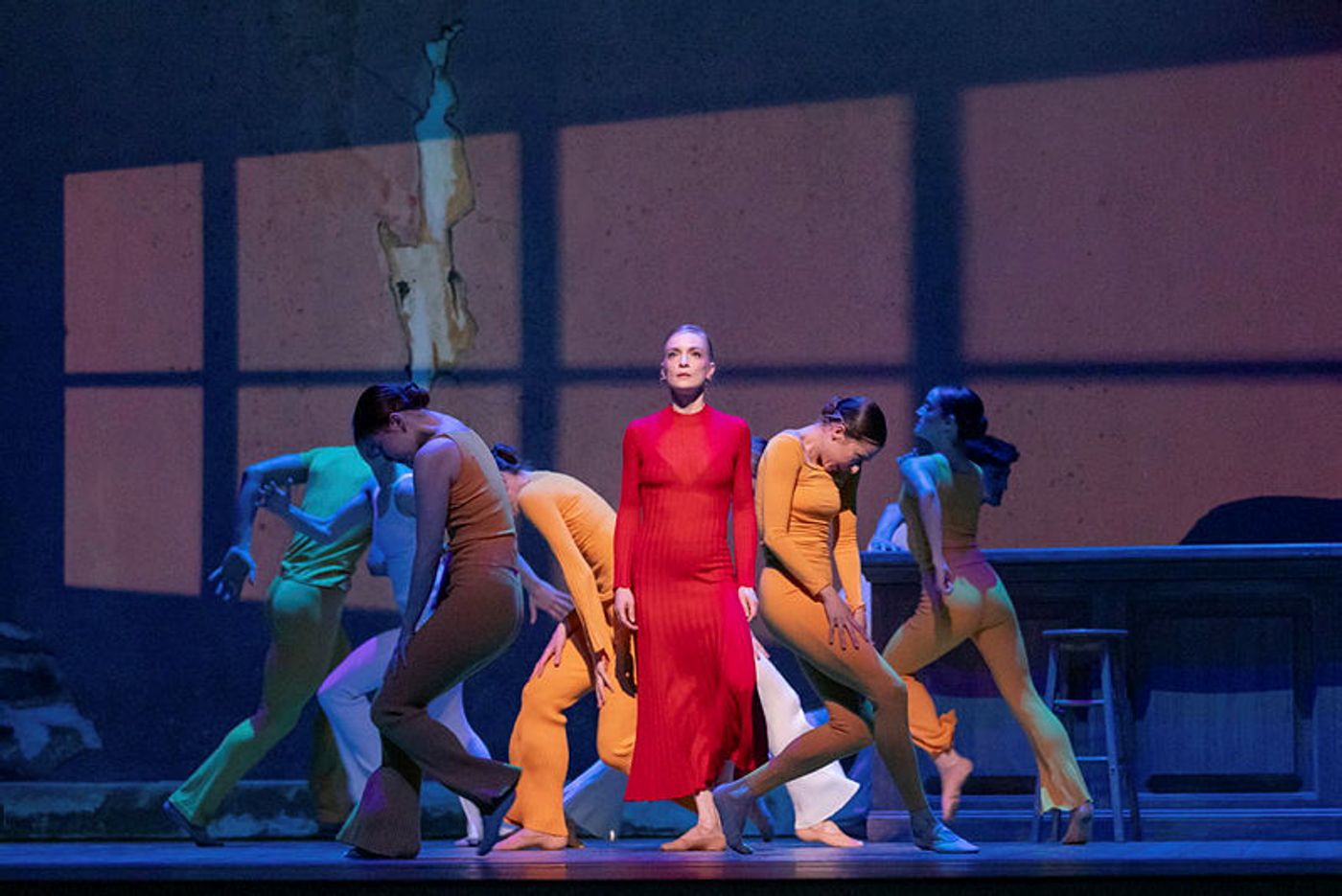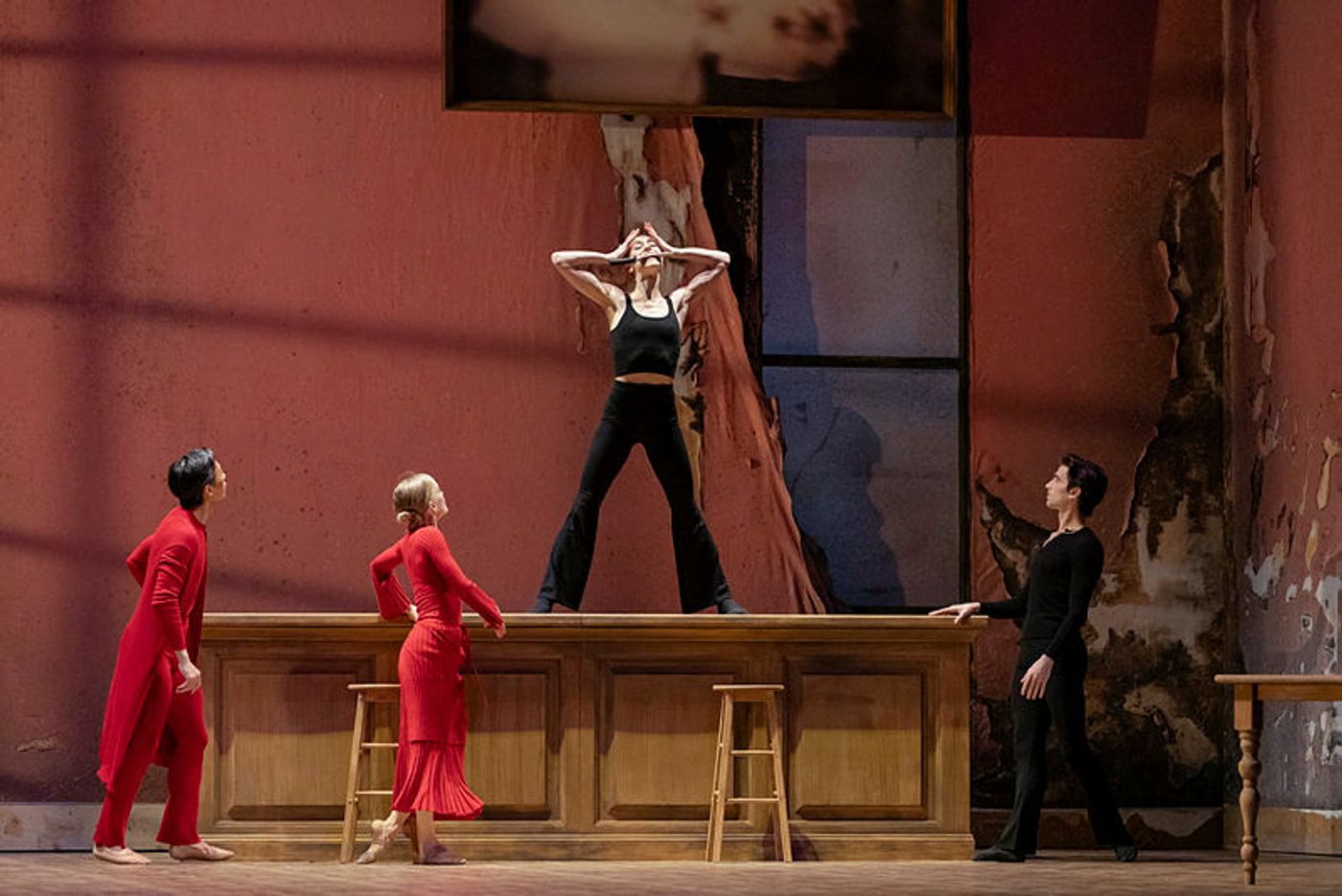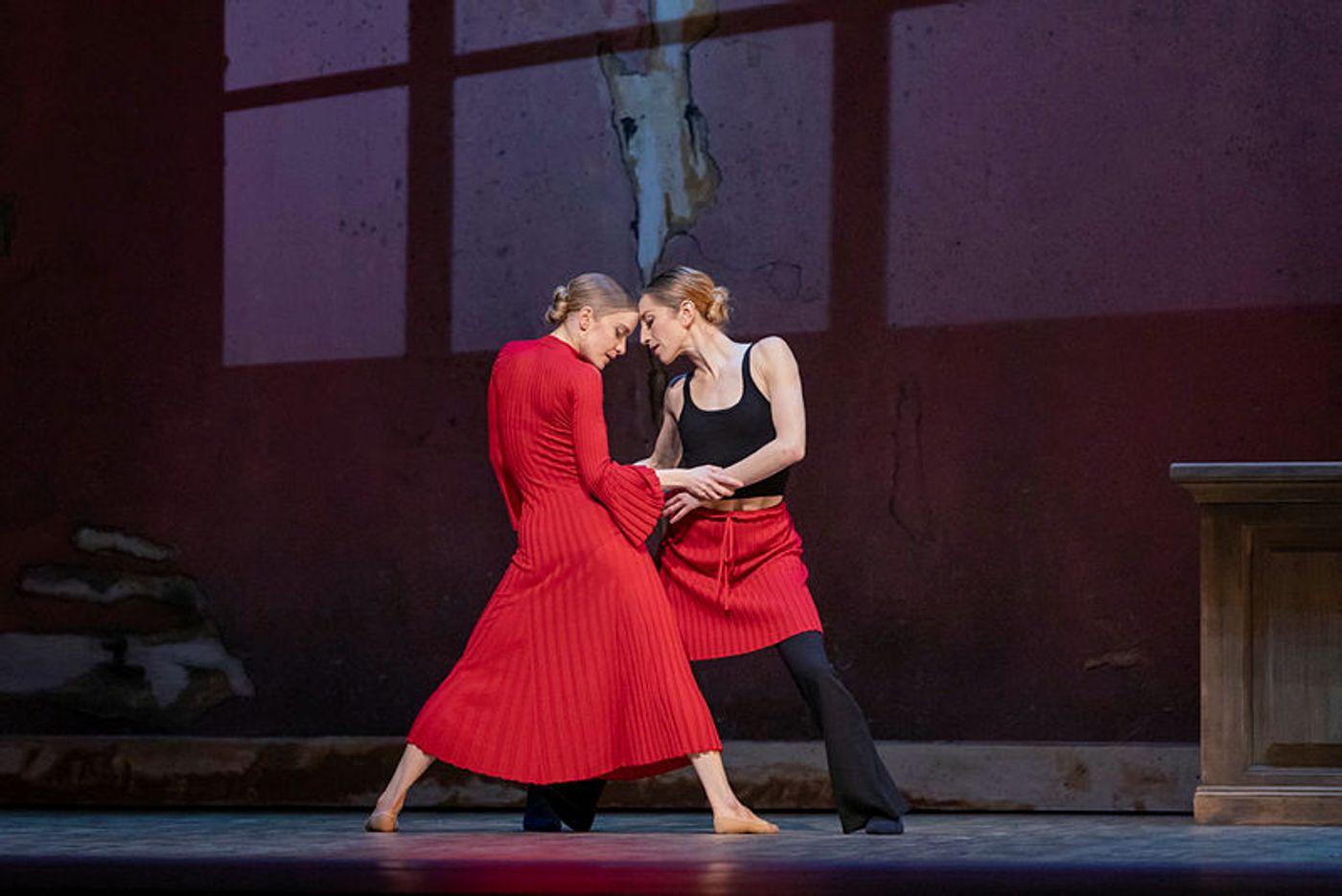Review: DOS MUJERES at San Francisco Ballet
The program of contemporary ballets by Latina choreographers runs through April 14th at the War Memorial Opera House

What a kick it was to enter the beaux arts grandeur of the War Memorial Opera House and be met with a massive scenic curtain designed by Oakland-based textile artist Maria Guzmán Capron. It was so vibrant and colorful that it energized the space even before I noticed the Latin music playing in the background. The curtain’s central image of two women’s faces merging into one also alluded to what we were about to experience.
To be honest, based on the descriptions from the press materials, I’d gone in a bit concerned the two ballets that comprise the program might be too similar. They are both contemporary one-act narrative ballets that celebrate strong women and are set to original scores. Well, it turns out the program is actually a fascinating study in contrasts – one ballet reinvents a fictional tale from a classic opera while the other is a biographical study of a very real woman. One uses brass-heavy orchestrations to accent its jazziness and the other uses brass to evoke the sound of mariachi music. One ballet is very sleek and stripped down while the other is a riot of color and imagination. One offers too little and the other offers if anything a little too much.

with Sasha De Sola (center) in the title role
The program opens with the world premiere of Arielle Smith’s Carmen. Much like Arturo O’Farrill’s score, Smith has taken the famous Bizet opera as her starting point, then largely refashioned it. She has pared away most of the plot and set her ballet in Cuba instead of Spain. In addition to a corps of nine dancers playing minor roles, there are four actual characters – Carmen, her husband Jose, her father Gilberto, and Escamillo who is now a female chef instead of a toreador. The relationship between Carmen and Jose is still fraught with issues, but in this telling she does not meet a tragic end, instead seeming to be lifted up by the women of her community. When that denouement arrived, though, it felt unearned, perplexing and just plain underwhelming.
While I’m all for updating the story – despite Bizet’s exceptional music, I’ve always found the opera a little icky and tending toward trauma porn – I can’t say this reimagining works. Perhaps it’s been distilled too far down in its roughly 35 minutes, but I often found the character motivations to be inscrutable. We seemed to be missing crucial scenes that might have shown why everyone acts the way they do. Just for starters, it was unclear to me why Gilberto has it in for Jose from the get-go or why Carmen is pulling Escamillo in for a passionate kiss only seconds after having met her. As thrilled as I was to finally see a lesbian love story at the center of a ballet (about damn time!), I just didn’t buy this one. And why does everyone keep gazing up at a blurry photo over the bar, presumably of Gilberto and his deceased wife? That gesture is repeated and repeated and repeated, and for me it led nowhere.

in San Francisco Ballet's production of Arielle Smith's Carmen
Despite the lack of narrative cohesion, I did find Smith’s choreographic style quite intriguing. Her movement is sort of communal Jerome Robbins meets slinky Twyla Tharp meets suave Gene Kelly. The first part of that triad is particularly apt given the many West Side Story echoes in O’Farrill’s music, replete with jazzy brass and Latin percussion. In fact, I found O’Farrill’s score such a fun listen that whenever I was confounded by the story, I thought of Balanchine’s famous suggestion that if one of his ballets failed to deliver the goods you can always just close your eyes and listen to the music.
Carmen’s design was also problematic. While I found both Riccardo Hernández’ set and Gabriela Hearst’s costumes quite attractive, they just didn’t belong in the same ballet. The grittiness, earth tones and peeling paint of Hernández’ inn were completely at odds with Hearst’s bright, monochromatic costumes so sleek and chic they wouldn’t be out of place on a contemporary runway.

in Arielle Smith's Carmen at San Francisco Ballet
Given the patchiness of the narrative, all four principals struggled mightily to fill in the dots and make sense of their characters as best they could. Sasha De Sola in the title role invested every moment with passion and superlative technique, yet I never felt like I knew who this woman was. Wei Wang as Gilberto seemed equally at sea despite valiant attempts to bring some cohesion to his scenes. As Don Jose, it was interesting to see Joseph Walsh’s usual nice-guy persona turned on its head, but I just didn’t understand the arc of his character. Jennifer Stahl as Escamillo pulled off a nifty knife sequence upon her entrance, but then wasn’t given much else to do other than snog with the leading lady. I felt bad for all four of them. When you’ve got artists of their caliber doing their darnedest and still falling way short of the mark, you’ve got a problem. Enough said.
After intermission came Annaelle Lopez Ochoa’s Broken Wings, originally choreographed on the English National Ballet in 2016. It’s a fantasia based on the life of artist and feminist icon Frida Kahlo, so automatically brings with it a lot of audience goodwill. Lopez Ochoa has created a ballet stuffed, well overstuffed actually, with a series of dances and stage pictures and fanciful characters that illuminate Kahlo’s story while incorporating allusions to imagery from her artwork. Along the way, we see her as a young schoolgirl falling in love with a boy before tragedy strikes (presumably the bus accident that caused her lifelong pain), her fateful first meeting with fellow artist Diego Rivera, his philandering with her sister among others, etc. Threaded throughout the narrative are all manner of fabulous sequences that enliven the piece and lend a vibe of magical realism that is very much in tune with Kahlo’s ethos. Even when she (spoiler alert?) dies at the end, it’s depicted not so much as a tragedy as a moment of triumphal ascendance into immortality.

in Annabelle Lopez Ochoas Broken Wings at San Francisco Ballet
Lopez Ochoa’s movement is varied and enthralling, including a sweetly romantic pas de deux for Frida and her first love and a more sexily contentious dance that depicts her initial seduction of Rivera. Her masterstroke is the invention of several anthropomorphized character groups that she weaves throughout the ballet. Particularly resonant were a group of Skeletons that related to the imagery in Kahlo’s art and the Mexican culture that was the wellspring of her creativity. They serve as mercurial spirit guides, a bit unsettling though not unfriendly, and possess a strangeness that feels like the afterlife. I don’t think I’ve ever seen anything quite like them before on a ballet stage.

in Annabelle Lopez Ochoa's Broken Wings at San Francisco Ballet
Even more fascinating were the ten Male Fridas. What a clever way to introduce the iconic images of the Frida we know so well from her myriad self-portraits without being too reverential or literal. Designer Dieuweke van Reij costumed the unibrowed men in brightly colored, ultrafeminine, flouncy, floor-length ruffled skirts over skintight tops that showed off their masculine musculature. The dancers were also crowned in different headpieces that recall the variety of ornate hair embellishments Kahlo often chose to depict herself wearing.
As the men flounced around the stage with utter self-possession and not an ounce of camp, they made an implicit commentary on the masculine/feminine duality in Kahlo’s work as well as on the performative nature of gender. Each dancer seemed to have been allowed some leeway to offer his own unique take on portraying femininity, yet none went so far as to seem over the top. I found their appearance and affect so beguiling that I couldn’t stop looking at them. These guys were all so compelling that they could easily sustain an entire ballet on their own. For the record, this beautifully matched team on opening night was comprised of Benjamin Davidoff, Daniel Deivison-Oliveira, Luca Ferrò, Lleyton Ho, Andris Kundzins, Joshua Jack Price, Jacob Seltzer, Jasper True Stanford, Myles Thatcher and Alexis Francisco Valdes.

in Annabelle Lopez Ochoa's Boken Wings at San Francisco Ballet
To give them such praise is not to slight the fabulous dancers in the leading and featured roles. Cavan Conley exuded old-time MGM panache as Frida’s young suitor. Sasha Mukhamedov brought a complicated maturity to the role of Frida’s sister. John-Paul Simoens (a former SFB dancer on loan from Oregon Ballet Theatre) had a welcome sense of gravitas and authority in his portrayal of Diego Rivera. But it was really Isabella Devivo’s moment to shine in the massive role of Frida. This longtime SFB soloist has been given her first big, juicy leading role and she did not waste the opportunity. I was especially entranced by her work in the earlier scenes where we got to see Frida’s girlishness and then her gradual awakening to her own powers. The tumultuous ovation that greeted DeVivo at the end was certainly well deserved.

(photo by Alexander Irwin)
When the scenic curtain came back down after the bows, the vivaciousness, passion and creativity of that glorious drop felt very much of a piece with the ballet we’d just seen, and the Opera House was abuzz with the kind of energy that can come when a convergence of artforms and cultures are beautifully in synch with each other.
(all photos except the last are by Reneff-Olson Productions)
---
Performances of San Francisco Ballet’s Dos Mujeres program continue through Sunday, April 14th at the War Memorial Opera House, 301 Van Ness Avenue, San Francisco, CA. Running time is approximately one hour fifty-five minutes, including one intermission. For tickets and additional information, visit www.sfballet.org or call (415) 865-2000, M-F 10am-4pm.
Reader Reviews
Videos

